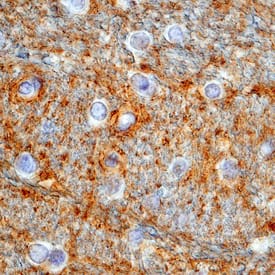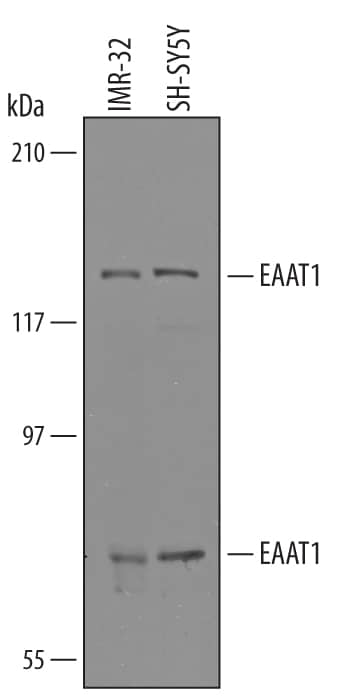Human EAAT1/GLAST-1 Antibody
R&D Systems, part of Bio-Techne | Catalog # AF6048

Key Product Details
Species Reactivity
Validated:
Cited:
Applications
Validated:
Cited:
Label
Antibody Source
Product Specifications
Immunogen
His146-Ser237
Accession # P43003
Specificity
Clonality
Host
Isotype
Scientific Data Images for Human EAAT1/GLAST-1 Antibody
Detection of Human EAAT1/GLAST‑1 by Western Blot.
Western blot shows lysates of IMR-32 human neuroblastoma cell line and SH-SY5Y human neuroblastoma cell line. PVDF Membrane was probed with 1 µg/mL of Sheep Anti-Human EAAT1/GLAST-1 Antigen Affinity-purified Polyclonal Antibody (Catalog # AF6048) followed by HRP-conjugated Anti-Sheep IgG Secondary Antibody (Catalog # HAF016). Specific bands were detected for EAAT1/GLAST-1 at approximately 60 and 120 kDa (as indicated). This experiment was conducted under reducing conditions and using Immunoblot Buffer Group 1.EAAT1/GLAST‑1 in Human Brain.
EAAT1/GLAST-1 was detected in immersion fixed paraffin-embedded sections of human brain (caudate nucleus) using Sheep Anti-Human EAAT1/GLAST-1 Antigen Affinity-purified Polyclonal Antibody (Catalog # AF6048) at 3 µg/mL overnight at 4 °C. Before incubation with the primary antibody, tissue was subjected to heat-induced epitope retrieval using Antigen Retrieval Reagent-Basic (Catalog # CTS013). Tissue was stained using the Anti-Sheep HRP-DAB Cell & Tissue Staining Kit (brown; Catalog # CTS019) and counterstained with hematoxylin (blue). Specific staining was localized to neuronal processes and presynaptic profiles. View our protocol for Chromogenic IHC Staining of Paraffin-embedded Tissue Sections.Applications for Human EAAT1/GLAST-1 Antibody
Immunohistochemistry
Sample: Immersion fixed paraffin-embedded sections of human brain (caudate nucleus)
Western Blot
Sample: IMR‑32 human neuroblastoma cell line and SH‑SY5Y human neuroblastoma cell line
Formulation, Preparation, and Storage
Purification
Reconstitution
Formulation
Shipping
Stability & Storage
- 12 months from date of receipt, -20 to -70 °C as supplied.
- 1 month, 2 to 8 °C under sterile conditions after reconstitution.
- 6 months, -20 to -70 °C under sterile conditions after reconstitution.
Background: EAAT1/GLAST-1
GLAST-1 (Sodium dependent GLu/ASp Transporter 1; also SLC1A3 and EAAT1) is a 60‑62 kDa member of the SDF symporter family of molecules. It is expressed by glia, fibroblasts, and select neuron cell types such as hippocampal neurons. EAAT1 is known to transport L‑glutamate into glia, thus removing glutamate from synaptic areas where it either acts too long, or becomes toxic at elevated concentration. Its action is dependent on its ability to cotransport sodium. Human EAAT1 is a 542 amino acid (aa), 8-transmembrane variably glycosylated protein that contains N- and C-terminal cytoplasmic domains. Homodimers are reported to exist, but only when EAAT1 shows glycosylation. There are at least two potential isoform variants. One shows an Arg substitution for aa 430‑475, while a second shows a four aa substitution for aa 62‑542. Over an extracellular loop that encompasses aa 146‑237, human EAAT1 shares 92% aa identity with mouse EAAT1.
Long Name
Alternate Names
Gene Symbol
UniProt
Additional EAAT1/GLAST-1 Products
Product Documents for Human EAAT1/GLAST-1 Antibody
Product Specific Notices for Human EAAT1/GLAST-1 Antibody
For research use only

